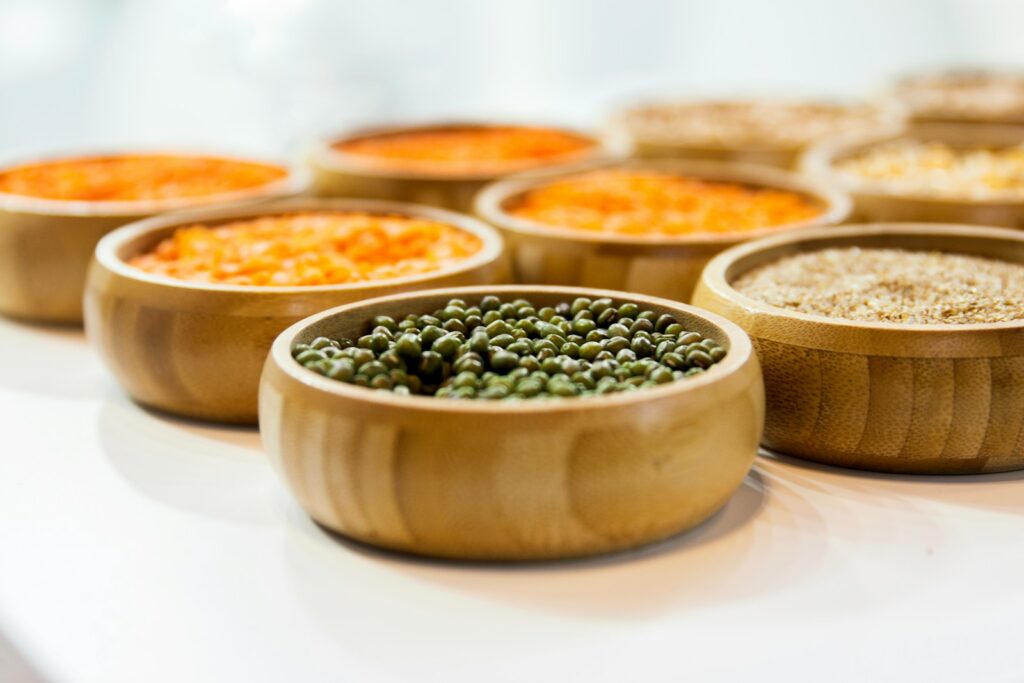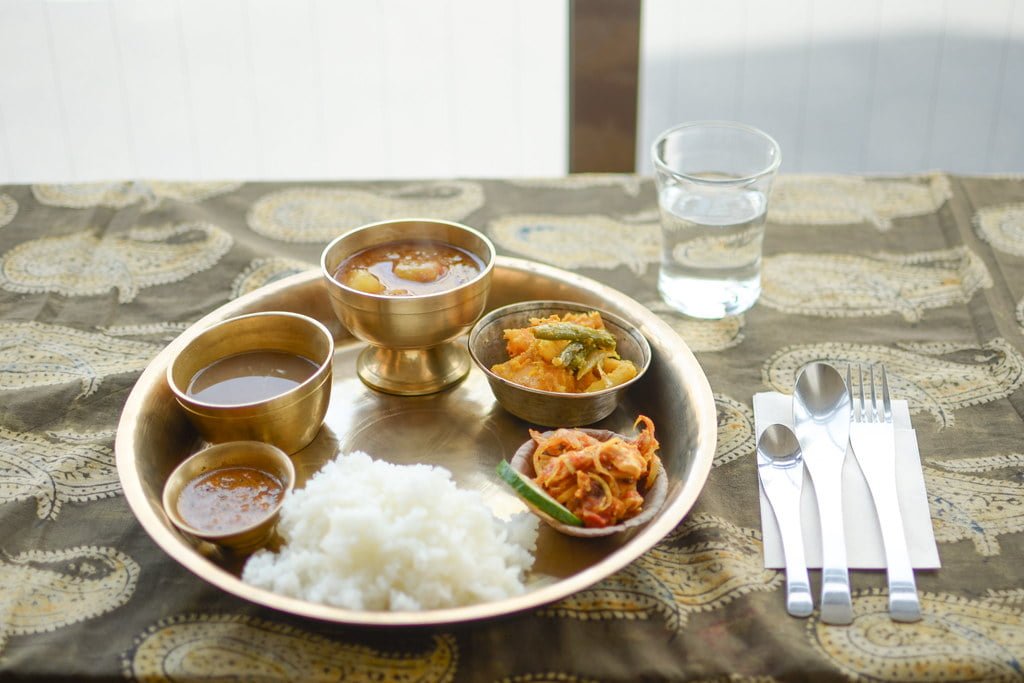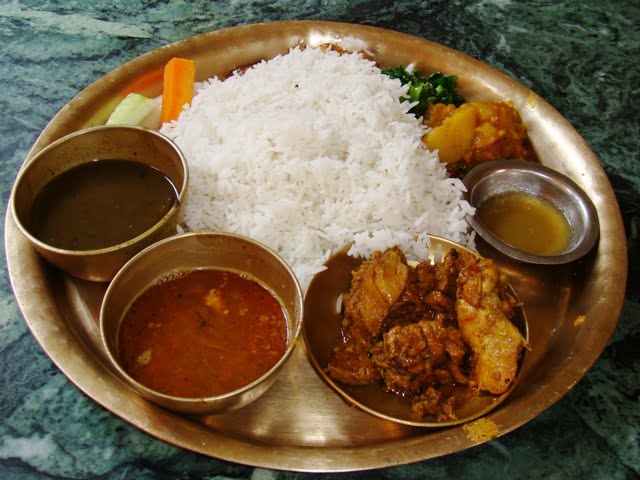Dal Bhat
Dal bhat is a traditional Nepalese meal that has been an essential part of the country’s culinary identity for centuries. The history of dal bhat dates back to ancient times when it was a staple food for the people of Nepal. The significance of dal bhat extends beyond its role as a simple meal and is deeply rooted in the cultural, social, and even religious aspects of Nepalese life.
The origins of dal bhat can be traced back to the traditional farming communities of Nepal, where the meal was a nutritious and sustaining option for hardworking farmers. As a result, dal bhat became synonymous with strength, nourishment, and sustenance, and it remains a symbol of resilience and endurance to this day.
In addition to its historical significance, dal bhat also holds religious and cultural importance in Nepal. It is a common offering to deities and is often prepared and shared during religious ceremonies, festivals, and special events. This emphasizes the communal and spiritual elements of dal bhat, highlighting its role in bringing people together and fostering a sense of unity and kinship within communities.
Furthermore, dal bhat’s significance extends beyond its cultural and religious connotations to encompass its nutritional value. The combination of lentil-based dal (a protein-rich stew) and bhat (steamed rice) provides a balanced and wholesome meal that fulfills the dietary needs of individuals, particularly in a landlocked country like Nepal where access to diverse food sources can be limited.
Overall, dal bhat’s history and significance are deeply intertwined with the traditions, values, and lifestyle of the Nepalese people, making it much more than just simple meal—it is a cultural icon that reflects the rich tapestry of Nepalese heritage.
Ingredients
Rice: Basmati vs. White vs. Brown Rice
When it comes to serving Dal Bhat, the type of rice used plays a crucial role in enhancing the overall flavor and texture of the meal. While Basmati, white, and brown rice are all popular choices, each one brings its own unique characteristics to the table. Here, we will explore the differences between Basmati, white, and brown rice to help you decide which one is best suited for your Dal Bhat experience.
- Basmati Rice: Known for its aromatic fragrance and delicate, elongated grains, Basmati rice is often considered the top choice for Dal Bhat. Its distinct flavor adds a subtle nuttiness to the dish and complements the rich flavors of the lentils and spices. Basmati rice also has a fluffy texture when cooked properly, providing a light and airy base for the dal and vegetable curry. If you want to elevate your Dal Bhat to a restaurant-style experience, using Basmati rice is highly recommended.
- White Rice: White rice, commonly used in traditional Dal Bhat preparations, provides a neutral and versatile base for the meal. It is less fragrant compared to Basmati rice but still offers a pleasant taste and texture. The grains are shorter and stickier, making it easier to scoop up the dal and vegetable curry. White rice is readily available and affordable, making it a practical choice for everyday meals.
- Brown Rice: For those looking to incorporate a healthier option into their Dal Bhat, brown rice is an excellent choice. Unlike white rice, brown rice retains its bran and germ layers, making it higher in fiber and nutrients. It has a slightly chewier texture and a nuttier flavor, adding a wholesome element to the meal. However, it is important to note that brown rice requires a longer cooking time compared to Basmati or white rice.
If you want to enjoy the authentic flavors and aromas of Dal Bhat, Basmati rice is the go-to option. However, if you prefer a more neutral base or are looking for a healthier alternative, white or brown rice would be suitable choices. Whichever rice you choose, one thing is certain – the combination of rice, lentils, and vegetable curry in Dal Bhat is a delicious and satisfying meal that will leave you craving for more.

Lentils: Types and Variations
When it comes to making dal bhat, the traditional Nepalese dish, choosing the right type of lentils is essential. While there are numerous types of lentils available, certain varieties are more commonly used in the preparation of dal bhat. Here, we will explore the different types of lentils and variations you can consider when making this flavorful dish.
- Brown Lentils: Brown lentils are the most commonly used lentils in dal bhat. They hold their shape well when cooked and have a slightly nutty flavor. Brown lentils are readily available in most grocery stores, making them a convenient option for dal bhat preparation.
- Red Lentils: Another popular choice for dal bhat is red lentils. These lentils cook quickly and tend to break down, resulting in a creamier texture. Red lentils also have a slightly sweet and earthy taste, adding depth to the dish.
- Mixed Lentils: For those who prefer a more diverse flavor profile, using a combination of lentils can be a great option. Mixed lentils can include a combination of green, red, and black lentils, offering a range of textures and flavors. This variation adds complexity to the dal bhat, making it a delightful and satisfying meal.
- Green Lentils: Although less commonly used in dal bhat, green lentils can also be incorporated for a unique twist. Green lentils have a robust flavor and hold their shape well, providing a hearty and wholesome element to the dish.
When choosing the type of lentils for your dal bhat, consider your personal preferences and the availability of lentils in your area. Experimenting with different lentil variations can add excitement and diversity to your dal bhat experience.
Additionally, you can customize the dal bhat by incorporating various spices and herbs. Traditional spices used in dal bhat include turmeric, cumin, coriander seeds, cinnamon, and cardamom. These spices add warmth and depth to the dish, elevating its flavor profile.
Aromatic Spices and Seasonings
Nepali cuisine is known for its vibrant and bold flavors, thanks to the extensive use of aromatic spices and seasonings. These ingredients play a crucial role in elevating the taste profile of dishes, creating a delightful culinary experience for those who indulge in Nepali cuisine.
Garlic, ginger, cumin, cinnamon, thyme, coriander, and many other aromatic spices are commonly used in Nepali cooking. These spices not only add depth and complexity to the dishes but also offer various health benefits. Garlic, for example, is known for its antibacterial and antiviral properties, while ginger aids in digestion and provides a warming sensation.
One of the most popular spice blends used in Nepali cuisine is the Garam Masala. This aromatic mixture typically includes cloves, cardamom, cinnamon, black peppercorns, and nutmeg. Garam Masala adds a rich and earthy flavor to curries, lentils, and meat dishes. Its warm and fragrant notes create a comforting and inviting aroma that entices the senses.
Turmeric, another staple spice in Nepali cuisine, not only adds vibrant color to dishes but also offers numerous health benefits. It is known for its anti-inflammatory properties and is widely used in curries and rice preparations like Dal Bhat. The combination of turmeric with other spices creates a harmonious blend of flavors that is both satisfying and nourishing.
The use of fresh herbs, such as cilantro and curry leaves, further enhances the aromatic profile of Nepali dishes. These herbs add a refreshing and vibrant touch to the overall flavor profile. Cilantro, in particular, is often used as a garnish to bring a burst of freshness to the final dish.
Vegetables: Cauliflower, Leafy Greens, Onions, Garlic, etc.
When it comes to Nepalese cuisine, the use of vegetables is a fundamental aspect of creating the perfect balance of flavors and textures in a dish. From the iconic dal bhat tarkari to various meat dishes, vegetables play a crucial role in adding depth and nutritional value to the meal.
One of the most commonly used vegetables in Nepalese cooking is cauliflower (Kauli). With its mild and slightly nutty flavor, cauliflower adds a delightful crunch to the tarkari. It is often cooked with a medley of other vegetables and aromatic spices, creating a harmonious blend of flavors.
Leafy greens are also a staple in Nepalese cuisine. Spinach is particularly popular and is commonly used as a base for many rice dishes. Its vibrant green color and earthy taste provide a refreshing contrast to the rich flavors of the dal bhat tarkari. Other leafy greens such as romaine lettuce and mustard greens are also used, adding their unique flavors and textures to the dish.
Onions and garlic are essential ingredients in Nepalese cooking, adding depth and aroma to the tarkari. They are often sautéed in oil or ghee along with other spices to create a flavorful base for the dish. The combination of onions and garlic, along with the aromatic spices like cumin, cinnamon, and coriander, infuses the tarkari with a beautiful complexity of flavors.
In addition to these vegetables, a variety of other ingredients can be incorporated into the tarkari. Spring onions, with their mild and slightly sweet taste, add a pleasant crunch to the dish. Fresh coriander, a herb widely used in Nepalese cuisine, lends a refreshing and fragrant note to the tarkari. The locals also utilize fermented and dried greens, such as gundruk or sinki, which are popular condiments in the mountainous regions of Nepal.

Cooking Process
The cooking process for dal bhat involves preparing the dal (lentils) and the bhat (rice) separately and then combining them to create a delicious and satisfying meal. Here is a step-by-step guide on how to cook dal bhat:
- Cooking the Dal:
- Rinse the yellow lentils thoroughly.
- In a pressure cooker or instant pot, set it to sauté mode and add oil.
- Add cumin seeds and nigella seeds to the hot oil and let them splutter.
- Add red chillies, chopped onions, garlic, and ginger to the pot and sauté until the onions turn translucent.
- Drain the soaked lentils and add them to the pot along with water and salt.
- Turn on the pressure cook mode and cook for 15 minutes.
- Allow the pressure to release naturally before opening the pressure pan.
- Mash the cooked lentils to achieve a smooth consistency.
- The dal is now ready to serve.
- Cooking the Rice (Bhat):
- Wash the rice and soak it in water for about 10 minutes.
- In a separate pot, add the soaked rice, water, and salt.
- Pressure cook the rice or use an instant pot to cook it until all the water is absorbed and the rice is cooked through.
- Allow the pressure to release naturally before opening the pot.
- Fluff the rice with a fork to separate the grains.
- Assembling the Platter:
- Scoop the cooked dal into a bowl and place it at the center of the serving platter.
- Arrange the cooked rice around the dal, creating a ring shape.
- Optionally, you can garnish the dal with fresh cilantro or chopped coriander leaves.
- Serve the dal bhat hot and enjoy the flavorsome combination of lentils and rice.
By following these simple steps, you can easily prepare a traditional Nepalese dal bhat meal. The combination of the creamy dal and fluffy rice makes for a hearty and nutritious dish that can be enjoyed on its own or paired with various side dishes such as vegetables, pickles, or grilled meats. Whether you are a fan of vegetarian cuisine or simply looking to explore new flavors, dal bhat is a must-try recipe that is sure to delight your taste buds.
Serving and Enjoying
Traditionally, Dal Bhat Tarkari is served with rice (Bhat), lentils (Dal), and a variety of vegetable choices (Tarkari). These components are typically presented in separate bowls or plates, allowing individuals to mix and match according to their preferences. The rice serves as a base, while the lentils and vegetables can be spooned over the rice or enjoyed separately.
One popular way to enjoy Dal Bhat Tarkari is by spooning the lentils and vegetables over the rice and then eating it with your hands. This traditional method of eating, often referred to as “eating with your fingers,” is a common practice in Nepal and adds a unique cultural element to the dining experience. The combination of flavors and textures creates a satisfying and comforting meal.
For those who prefer using utensils, a spoon is commonly used to scoop the lentils and vegetables onto the rice. This method allows for easier control and can be less messy than eating with your hands. It is important to note that there is no right or wrong way to enjoy Dal Bhat Tarkari – it is purely a matter of personal preference.
To enhance the flavors of Dal Bhat Tarkari, it is often served with accompaniments such as yogurt and Indian pickled vegetables (achar). These additions add a tangy and refreshing element to the dish, complementing the richness of the lentils and vegetables. Mango pickles and plain yogurt are popular choices that pair well with the flavors of Dal Bhat Tarkari.
Additionally, some individuals choose to serve Dal Bhat Tarkari alongside a vegetable curry called Tarkari. This combination creates a well-rounded and satisfying meal, providing a variety of flavors and textures. However, if you prefer to enjoy just the lentils and rice, it is equally delicious and fulfilling on its own.
Is Nepali Dal Bhat healthy?
Nepali Dal Bhat is a healthy meal option that offers a balanced combination of carbohydrates, protein, and essential nutrients. Its plant-based nature, affordability, and nutritional value make it an excellent choice for individuals seeking a nourishing and satisfying meal.
First and foremost, Dal Bhat is a plant-based meal that is always vegetarian and can easily be made vegan by using oil instead of ghee. This makes it an excellent choice for individuals following a vegetarian or vegan diet. The dish is packed with essential nutrients, including carbohydrates, protein, fluid, vitamins, and minerals. It provides the body with the necessary fuel to sustain energy levels, especially in the extreme conditions of the Himalayas.
The combination of lentils and rice in Dal Bhat offers a complete protein source. Lentils are rich in protein and contain the essential amino acids needed by the body. Rice, on the other hand, is a good source of carbohydrates, providing the energy required for physical activities and overall bodily functions. This makes Dal Bhat an ideal meal for those engaging in strenuous activities, such as trekking in the mountains.
Moreover, the inclusion of vegetables in the form of Tarkari, a vegetable dish often served alongside Dal Bhat, adds even more nutritional value to the meal. Vegetables are rich in vitamins, minerals, and fiber, which are vital for maintaining a healthy diet. The variety of spices used in Nepali cuisine also contributes to the overall nutritional profile of the dish, as many spices are known for their health benefits and antioxidant properties.
Another aspect that adds to the healthiness of Dal Bhat is its affordability. In Nepal, where access to expensive ingredients may be limited in some areas, Dal Bhat provides a cost-effective and nutritious option for daily meals. This makes it a popular choice among locals and trekkers alike.
In conclusion, Nepali Dal Bhat is a healthy meal option that offers a balanced combination of carbohydrates, protein, and essential nutrients. Its plant-based nature, affordability, and nutritional value make it an excellent choice for individuals seeking a nourishing and satisfying meal. Whether you’re fueling yourself for a trek in the Himalayas or simply looking for a wholesome vegetarian dish, Dal Bhat is a dish that delivers both taste and nutrition.
What is the difference between Dal and Dal Bhat?
Dal and Dal Bhat are both popular dishes in Nepal and the Indian subcontinent, but they have some key differences. Dal is a soup made from legumes, while Dal Bhat is a complete meal that includes Dal and steamed rice. While Dal can be enjoyed as a standalone dish, Dal Bhat provides a more substantial and balanced meal with the addition of rice.
Dal, which refers to legumes such as lentils, beans, or peas, is a type of soup made from these legumes. It is a staple dish in Nepali cuisine and is often served with rice or roti (Indian bread). Dal is a versatile dish that can be prepared with various types of legumes and flavored with spices such as cumin, turmeric, and ginger. It is typically cooked until the legumes are soft and the soup reaches a thick consistency.
On the other hand, Dal Bhat is a complete meal that consists of Dal and Bhat, which means steamed rice. It is considered the national dish of Nepal and is a common meal consumed twice a day by locals and trekkers in the Himalayas. Dal Bhat is known for its simplicity, affordability, and nutritional value. It provides a balanced combination of protein from lentils and carbohydrates from rice.
While Dal can be enjoyed as a standalone dish, Dal Bhat combines the lentil soup with steamed rice, creating a hearty and satisfying meal. It is often served with Tarkari, a spicy vegetable curry that adds flavor and nutrition to the dish. The Tarkari can vary depending on the cook and the availability of seasonal vegetables.
The main difference between Dal and Dal Bhat lies in the inclusion of rice in the latter. Dal Bhat is a more substantial and filling meal compared to Dal alone. The combination of lentils and rice provides a good balance of nutrients and energy, making it a popular choice for locals and trekkers in Nepal.

